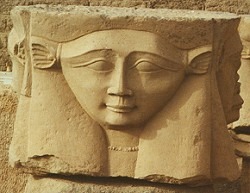
Goddess whose name means 'House of Horus'. She was considered to be the mother of the ruling pharaoh, who was identified with Horus. She was worshipped everywhere in Egypt, with her most important cult centre at Dendera. Many of the other places with which she was connected are mentioned in a number of ancient Egyptian lists of the various Hathor goddesses. They are to be found in the temples of Karnak, Edfu and Dendera, among others. She was also worshipped outside Egypt, for example in Nubia, Byblos and the Sinai. A temple dedicated to her as 'Lady of Turquoise' was built at the turquoise mines of Serabit el-Khadim. Another of her titles was 'Lady of Faience'. Hathor was linked with many of the cow goddesses which appear in Egyptian mythology, thus emphasizing the cosmic aspects of her being. She caused the sun god Re to be reborn daily, as did the goddess Nut elsewhere. Her life-giving role as 'Lady of Life' was underlined in the mammisi or birth houses of many temples. As a result, she was also important to the dead. As a funerary goddess she was depicted on papyri and in tombs, often as a cow emerging from the western mountains through the papyrus plants. The goddess was also associated with the Eye of Re. In one version of the myths concerning the Eye, an angry Hathor wanted to exterminate the human race. She was only pacified by a trick: a large amount of beer was mixed with red ochre, giving it the colour of blood. The goddess feasted on this and when she was drunk her anger passed, thus saving part of the human race. Because of her capricious nature, as illustrated in this myth, she was associated not only with the fearsome lioness Sakhmet but also with the sweet-natured cat Bastet, as well as with many other goddesses. Not only was she closely linked with the other mother goddess Isis (who 'borrowed' her crown with cow's horns from Hathor) but also with goddesses such as Sothis, Maat, Wadjet, Nekhbet and many others. In addition to those already mentioned, Hathor had many other functions. She was involved in determining the fate of newborn children and was associated with music (see Sistrum) and with sexuality. Hathor was depicted in the form of a woman with cow's horns on her head, between which was a sun disk, or else entirely as a cow. Her face alone was also often depicted, for example as part of a sistrum or on top of the columns in the hypostyle hall in Dendera, when she has a human face with a cow's ears. In connection with her fiery nature she is also sometimes depicted as a lioness.